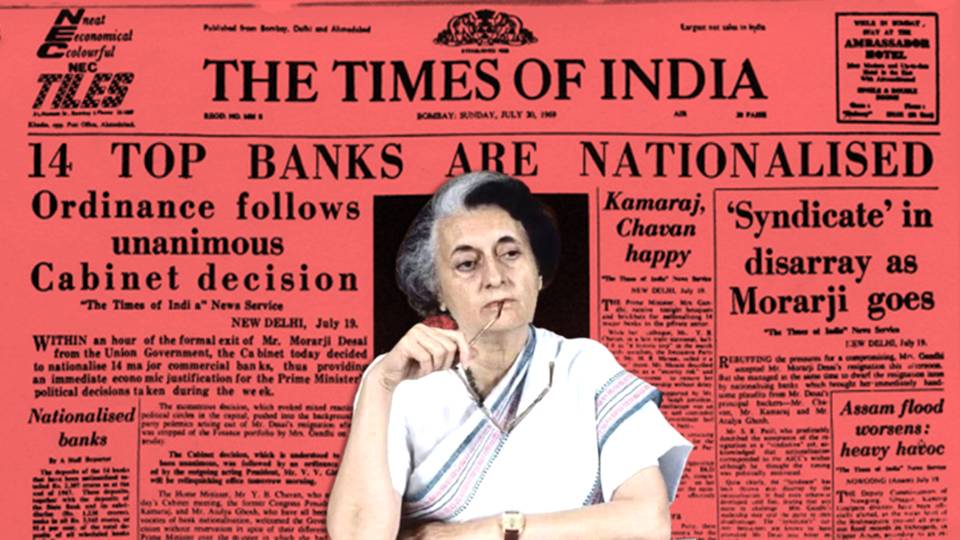The Indian economy, five decades back, was thrown under the bus by the Indira Gandhi-led government. The party took the first step in ruining the economy of the nation just to win elections and that was the nationalisation of each and every bank in the country at the time. While the decision is known as the single-most important economic policy decision taken by any government after 1947, it should be noted that it was all about political gains, which led to the economic destabalisation of the nation.
Nationalisation of Banks
Congress party performed poorly in the 1967 general elections and lost its command in many states. The review committee which was set up to review the performance of the party concluded that slow progress towards ‘socialism’ is the reason behind loss of the party.
The first step suggested to solve this political problem was ‘Nationalisation of Banks’. Morarji Desai, the then finance minister and Deputy Prime Minister was sacked by Indira Gandhi as he was reform minded and would have resisted the bank nationalisation move. A leader as authoritarian as Indira Gandhi obviously did not like independent minded leaders.
Read more: Bank nationalisation: 50 years on, Indira Gandhi’s massive blunder still costs India
After removal of Desai, the decision of nationalisation of every private bank was implemented on the 19th of July, 1969. At that time, these banks controlled 85 per cent of total deposits and therefore practically the whole banking sector came under government control.
A political success
While the so-called defenders of bank nationalisation claim its positive outcomes, the reality was far from it. The nationalisation of banks was primarily a political ploy by Indira Gandhi to split the Congress, but there is another reason behind it too. The decision was taken to combat and crush the Swatantra Party, which had emerged as the greatest threat to Congress hegemony at that time.
The Swatantra Party was formed in 1957 by C Rajagopalachari, N G Ranga, K M Munshi, and other eminent Congressmen who did not really like Jawaharlal Nehru’s socialist policies. The party thus got the support of princes, zamindars and businessmen who disliked Nehru’s land policies.
In 1962, the Swatantra Party won 18 seats, just behind Congress and the Communist Party of India. In 1967, as a consequence of what India was made to suffer, Congress won only 283 of 520 seats and Swatantra, with 44 seats, became the Opposition spearhead.
Read more: Indira Gandhi could have won back Pakistan occupied Kashmir in 1971, but she had other ideas
In order to attack Swatantra party, the princes and businessmen were subjected to income and wealth tax leading to them becoming poor. The income-tax rate was increased to 97.75%, plus a wealth tax of 3.5%. The finances of big businesses were hit by these moves and especially due to bank nationalisation. Indiara Gandhi also nationalised several more businesses. She hit the industrialists and businessmen where it hurt the most. All of that was done only to attack Swatantra Party, which was smashed to smithereens.
An economic failure
The reason given behind the disastrous step of the nationalisation of banks was that the government wanted to increase the rural penetration of each bank and prioritize the lending to MSMEs. Both things remain a distant dream. Five decades of improvements on this front that can be accredited to any nationalised bank is negligible. Even if the government mandated that every private sector bank must have a certain percentage of branches in rural areas and certain percentage of lending must go to MSMEs, the situation would have been much better.
Due to credit planning, the interest rate structure became very complex. Since there were different rates of interest for different types of loans, the Indian central bank ended up handling hundreds of interest rates leading to the formation of a mind-boggling structure, which was brought down only after the 1991 reforms.
The nationalisation of banks made them a highly political entity. The loans to corporates were being decided on their cosiness with the political establishment. In fact, one can argue that the high time of ‘crony capitalism’ started with the nationalisation of banks. The accumulation of bad loans in Public Sector Banks is proof that they are more prone to bad decisions.
Had it been Lal Bahadur Shastri in the power, things would have been different. However, Indira Gandhi had to support the Left. Bank nationalisation was one of her responses to the economic and political challenges of the time. Banks had to push funds where the government wanted to target for growth. It was overall a political strategy to crush her opponents.
In economic terms, the nationalisation of banks is still believed to be a failure, but in political terms, it was a brilliant success. It smashed all the opponents which were once contenders to rule India.
Support TFI:
Support us to strengthen the ‘Right’ ideology of cultural nationalism by purchasing the best quality garments from TFI-STORE.COM
